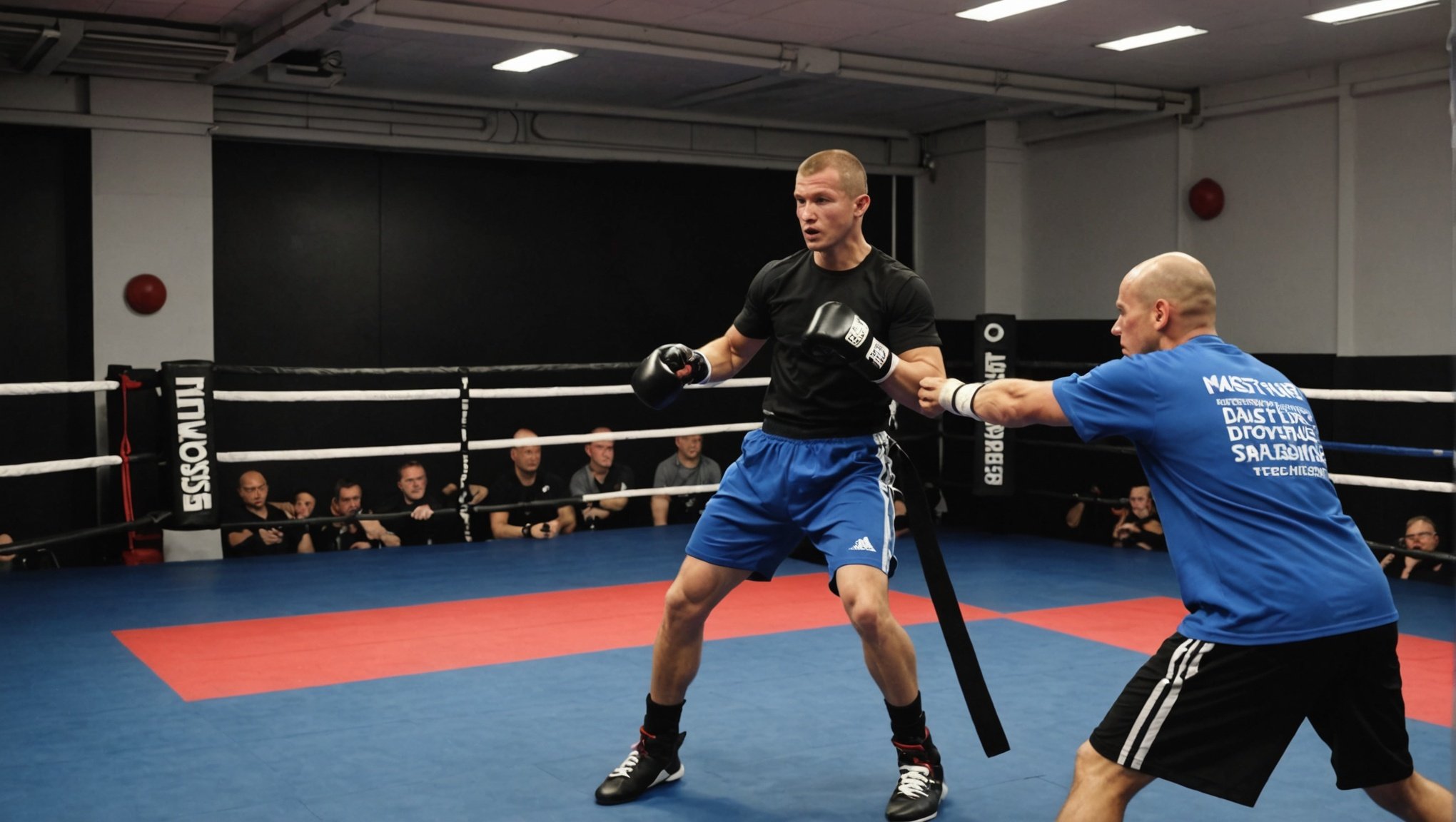Mastering Defense: Innovative Shadowboxing Techniques for UK Kickboxers
Understanding the Importance of Defense in Kickboxing
When it comes to kickboxing, the focus often shifts to the offensive aspects – the powerful kicks, the precise punches, and the dynamic combinations. However, defense is equally, if not more, crucial for any kickboxer aiming to excel in the sport. Defense is not just about avoiding strikes; it’s about creating opportunities to counterattack and gain the upper hand in a fight.
“Defense is the backbone of any martial art,” says Ray Sabur, a renowned boxing coach. “It’s what separates the good fighters from the great ones. Without a solid defensive foundation, you’re leaving yourself open to a world of trouble.”
In the same genre : Mastering Mental Strength: Strategies for UK Combat Sports Athletes to Conquer Performance Anxiety
The Role of Shadowboxing in Defensive Training
Shadowboxing is a fundamental training method that allows kickboxers to practice their techniques without an opponent. It’s an excellent way to focus on form, footwork, and overall defensive strategy.
Why Shadowboxing?
- Improves Technique: Shadowboxing helps you refine your punches, kicks, and footwork. By practicing in front of a mirror or without an opponent, you can focus on the precision and execution of each move.
- Enhances Footwork: Good footwork is essential for defense. Shadowboxing allows you to practice moving fluidly, shifting your weight, and maintaining balance, all of which are critical for evading strikes and creating counterattack opportunities[1].
- Boosts Cardio: Shadowboxing can be a high-intensity workout, helping you improve your cardiovascular endurance. This is particularly beneficial for kickboxing, where fights can be physically demanding and require sustained energy levels.
Innovative Shadowboxing Techniques for Defense
Here are some innovative shadowboxing techniques that UK kickboxers can incorporate into their training to enhance their defensive skills:
Also read : Unlocking Flexibility: Dynamic Stretching Techniques for UK Karate Practitioners
1. Focus on Foot Placement
When shadowboxing, pay close attention to your foot placement. Practice shuffling, bobbing, and weaving to improve your ability to move around the ring or mat. Use agility ladders or cones to create a more dynamic and challenging environment[2].
2. Hand Defense Drills
- Slipping and Bobbing: Practice slipping punches by moving your head to the side and bobbing to avoid incoming strikes.
- Blocking and Parrying: Use your arms to block and parry imaginary punches. Focus on keeping your hands up and your elbows close to your body.
- Hand Rotation: Rotate your hands to simulate the motion of deflecting punches. This helps in developing the reflexes needed to react quickly to incoming strikes.
3. Trunk Defense
- Twisting and Turning: Practice twisting your torso to avoid body shots. This movement helps in reducing the impact of kicks and punches aimed at the body.
- Guard Position: Maintain a guard position with your hands up and your elbows close to your body. Practice moving in and out of this position to simulate defensive movements.
4. Combination Drills
- Punch-Kick Combinations: Practice combinations that include both punches and kicks. For example, a jab-cross-hook followed by a roundhouse kick.
- Defense-Counterattack Sequences: Simulate defensive movements followed by immediate counterattacks. For instance, slipping a punch and then throwing a quick jab or cross.
Practical Tips for Effective Shadowboxing
Here are some practical tips to make your shadowboxing sessions more effective:
Use Mirrors and Reflections
Practice in front of a mirror to observe your form and technique. This helps in identifying any flaws and making necessary adjustments.
Incorporate Music and Timers
Use music or timers to simulate the rounds and intervals of a real fight. This helps in building endurance and mental toughness.
Mix Up Your Routine
Vary your shadowboxing routine to avoid monotony. Include different types of drills, such as footwork drills, hand defense drills, and combination drills.
Focus on Breathing and Relaxation
Keep your breathing steady and relaxed. Avoid tensing up, as this can lead to fatigue and decreased performance.
Equipment Essentials for Shadowboxing
While shadowboxing itself doesn’t require much equipment, having the right gear can enhance your training experience.
Boxing Gloves
- Why Gloves?: Wearing boxing gloves during shadowboxing helps you get used to the weight and feel of the gloves, which is crucial for actual sparring or fights.
- Recommendation: Opt for lighter gloves (12-14 oz) for shadowboxing to improve hand speed and agility.
Hand Wraps
- Protection: Hand wraps provide additional support and protection for your hands and wrists.
- Recommendation: Use Perfect Stretch Hand Wraps for optimal comfort and support[1].
Shin Guards
- Protection: Although not necessary for shadowboxing, shin guards can be useful if you plan to incorporate kicks into your routine.
- Recommendation: Choose adjustable shin guards like Hayabusa T3 Full Back Shin Guards for complete coverage and mobility[1].
Table: Comparing Different Shadowboxing Drills
| Drill Type | Benefits | Tips for Execution |
|---|---|---|
| Footwork Drills | Improves agility, balance, and overall movement | Use agility ladders or cones to create a dynamic environment. Practice shuffling, bobbing, and weaving. |
| Hand Defense Drills | Enhances ability to slip, block, and parry punches | Keep hands up and elbows close. Practice rotating hands to deflect punches. |
| Trunk Defense Drills | Develops twisting and turning to avoid body shots | Maintain a guard position. Practice moving in and out of this position. |
| Combination Drills | Improves coordination and timing of punches and kicks | Practice combinations like jab-cross-hook followed by a roundhouse kick. Simulate defense-counterattack sequences. |
| Shadowboxing with Music/Timers | Builds endurance and mental toughness | Use music or timers to simulate rounds and intervals. Keep breathing steady and relaxed. |
Quotes from Experts and Fighters
- “Shadowboxing is not just about throwing punches and kicks; it’s about perfecting your technique, improving your footwork, and enhancing your overall defensive strategy.” – Ray Sabur, Boxing Coach.
- “I spend at least 30 minutes a day shadowboxing. It’s how I refine my skills and stay sharp between fights.” – A UK Kickboxer.
- “Defense is not just about avoiding strikes; it’s about creating opportunities to counterattack. Shadowboxing helps you develop the reflexes and instincts needed for this.” – A Muay Thai Trainer.
Incorporating Shadowboxing into Your Training Routine
To get the most out of shadowboxing, it’s important to incorporate it into your regular training routine.
Frequency and Duration
Aim to shadowbox at least 2-3 times a week, with each session lasting around 20-30 minutes. This can be in addition to your regular kickboxing classes or training sessions.
Combining with Other Training Methods
Shadowboxing can be combined with other training methods such as heavy bag training, sparring, and cardio kickboxing. For example, you could shadowbox for 15 minutes, then move to heavy bag training for another 15 minutes.
Mastering defense in kickboxing is a multifaceted process that requires dedication, patience, and the right training techniques. Shadowboxing is a powerful tool that can help UK kickboxers enhance their defensive skills, improve their technique, and build the endurance and mental toughness needed to excel in the sport.
By incorporating innovative shadowboxing techniques into your training routine, you can take your kickboxing to the next level. Remember to focus on foot placement, hand defense, trunk defense, and combination drills. Use the right equipment, and make sure to mix up your routine to keep your training sessions engaging and effective.
In the words of a seasoned kickboxer, “Shadowboxing is the unsung hero of kickboxing training. It’s where you build the foundation that makes you a formidable opponent in the ring.” So, lace up your gloves, wrap your hands, and get ready to shadowbox your way to better defense and a stronger kickboxing game.












